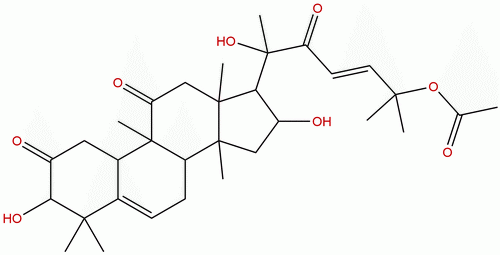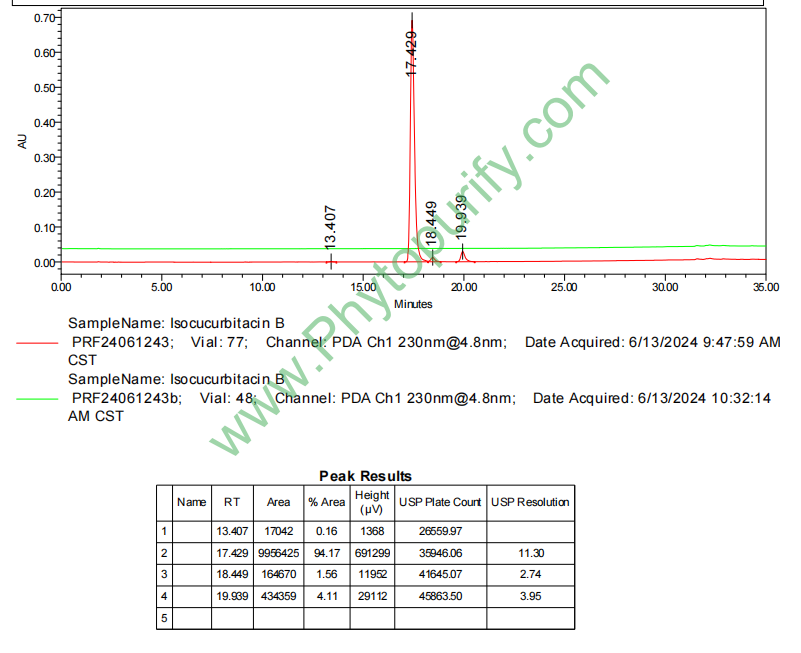
Isocucurbitacin BCAS No.:17278-28-3
|
||||||||||
 |
|
|
||||||||

| Catalogue No.: | BP3973 |
| Formula: | C32H46O8 |
| Mol Weight: | 558.712 |
Product name: Isocucurbitacin B
Synonym name:
Catalogue No.: BP3973
Cas No.: 17278-28-3
Formula: C32H46O8
Mol Weight: 558.712
Botanical Source: Cucumis melo L.
Physical Description:
Type of Compound:
Purity: 95%~99%
Analysis Method: HPLC-DAD or/and HPLC-ELSD
Identification Method: Mass, NMR
Packing: Brown vial or HDPE plastic bottle
The product could be supplied from milligrams to grams
Inquire for bulk scale.
For Reference Standard and R&D, Not for Human Use Directly.
Description:
Isocucurbitacin B has significantly activities against HeLa and HT-29 human cancer cells with IC50 values ranging from 0.93 to 9.73uM.
References:
J Ethnopharmacol. 2015 Jul 1;169:18-23.
Bioassay-guided isolation and identification of cytotoxic compounds from Bolbostemma paniculatum.
Four cucurbitacine triterpenoid sapogenins, Isocucurbitacin B(1), 23,24-dihydroIsocucurbitacin B(2), cucurbitacin E(3), 23,24-dihydrocucurbitacin E(4), and 11 triterpenoid saponins, tubeimosideI(5), tubeimoside III(6), tubeimoside V(7), dexylosyltubeimoside III(8), lobatoside C(9), tubeimoside A(10), tumeimoside B(11), lobatoside A(12), tubeimoside C(13), tubeimoside IV(14), 7β,18,20,26-tetrahydroxy-(20S)-dammar-24E-en-3-O-α-L-(4-acetyl)arabinopyranosyl-(1→2)-β-D-glucopyranoside(15) were isolated from the active EtOAc and n-BuOH extracts.
METHODS AND RESULTS:
Of them, compounds 2, 4, 9 and 12 were firstly isolated from the Bolbostemma genus. MTT assay revealed that compounds 1, 3 and 4 had significantly activities against HeLa and HT-29 human cancer cells with IC50 values ranging from 0.93 to 9.73μM. It is worth mentioning that compound 4׳s activities against the two cell lines are 12- and 8-fold that of the positive control drug (5-Fu). Whereas, the cyclic bisdesmosides 5-9 exerted significantly activities on BGC-823, HeLa, HT-29 and MCF-7 cancer cells with IC50 values ranging from 1.30 to 15.64μM. And 6׳s activities against the four cell lines are 6-, 3-, 10- and 16-fold that of 5-Fu and 8׳s activities against the four cell lines are 5-, 3-, 14- and 9-fold that of 5-Fu.
CONCLUSIONS:
The cytotoxic activity of the bulbs of B. paniculatum is mainly ascribable to cucurbitacine triterpenoid sapogenins (1-4) and the cyclic bisdesmosides (5-9). The cyclic bisdesmosides are the main anti-cancer active compounds of B. paniculatum. The above results provide scientific evidence to support, to some extent, the ethnomedicinal use of B. paniculatum as anticancer remedies in traditional Chinese medicine.
HPLC of Isocucurbitacin B
